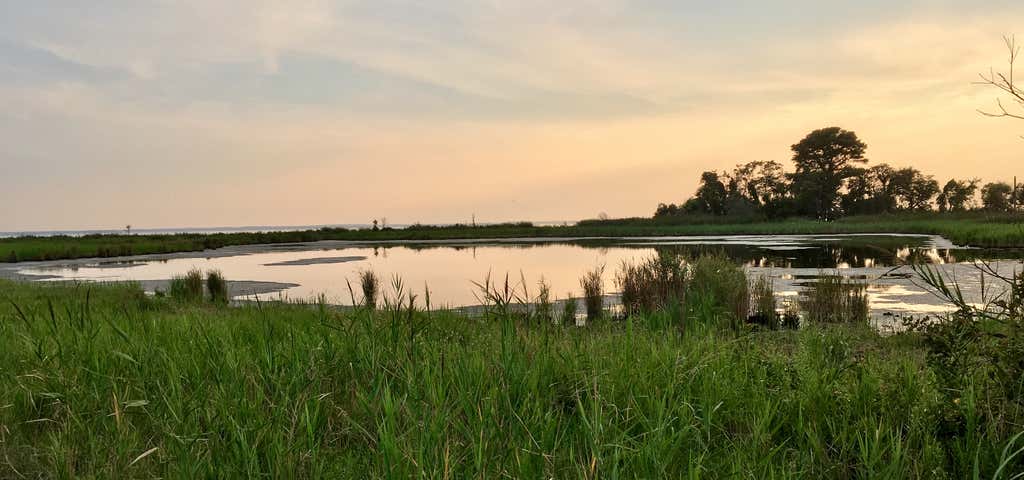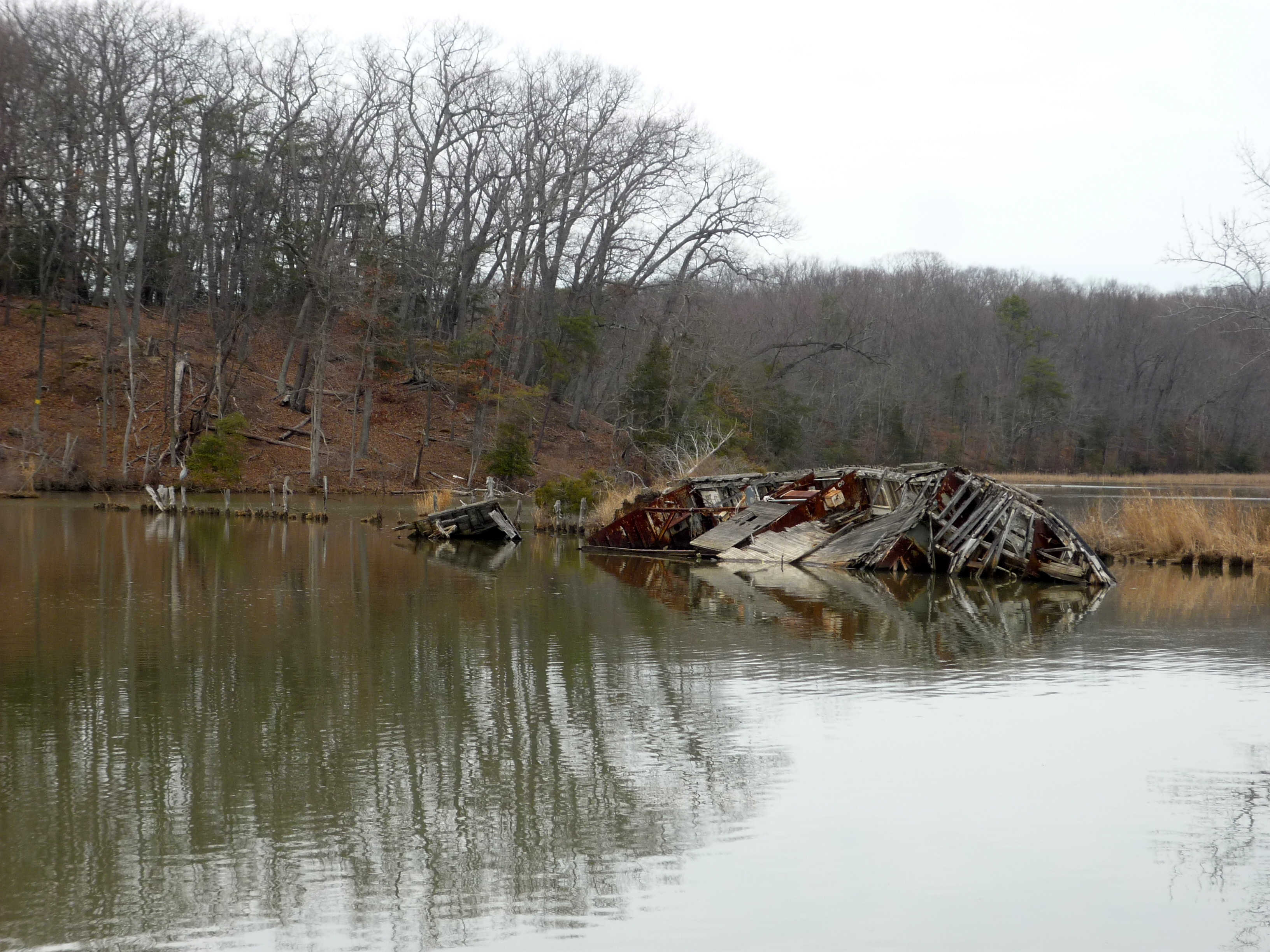Written by Malee Oot
Bounded by the Chesapeake Bay and a slew of massive rivers, southern Maryland is a region shaped by water. The area’s lengthy history is inextricably linked to the Chesapeake Bay, the largest estuary in the country, and a hub of biodiversity. Historically, the massive estuary sustained the region’s early Piscataway and Yaocomaco inhabitants, brought colonial-era settlers from Europe, and fueled local economies. Today, southern Maryland is still dotted with communities closely tied to the Bay, spread over a landscape loaded with natural wonders, charming towns, and plenty of maritime lore.
Just 40 miles south of Washington, D.C., a bulge in the Potomac River has become the final resting place for more than 150 sunken vessels, including a longboat from the Revolutionary War. Now protected as the Mallows Bay-Potomac National Marine Sanctuary, the ship graveyard harbors the remains of an entire emergency fleet of wooden steamships, hastily constructed during the first World War, when German submarines were creating havoc in the seas. Even with shipyards around the country churning out the wooden steamers, the emergency fleet wasn’t ready before the end of the war, and had little value. After a few attempts to scrap the vessels, the steamers were eventually left to decay in the Potomac River.
Over the years, the ships have been reclaimed by nature, and now provide a nesting place for osprey, and habitat for the striped bass, channel catfish, and white perch lurking beneath the surface. The best time to spy the sprawling ship graveyard is during low tide, and the Mallows Bay Park provides the best vantage point for viewing the partially-submerged ships from the shoreline.
2
The Dr. Samuel Mudd House & Museum
After shooting President Abraham Lincoln during a theater production of Our American Cousin in Washington, John Wilkes Booth headed for the tidewater region of southern Maryland, where he was aided by his accomplice, David Herold. Once in Maryland, the pair stopped at Mary Surratt’s Tavern for provisions, then hurried to the house of Dr. Samuel Mudd, arriving just before dawn on April 15, 1865. The fugitives rested at Mudd’s home, and the doctor treated Booth’s broken leg.
Although Mudd’s role in the conspiracy to assassinate Lincoln has been debated, the doctor received a life sentence for harboring Booth and Herold, and was sent to Fort Jefferson, now part of Dry Tortugas National Park. After serving a little more than three years of his sentence, Mudd received a pardon from President Andrew Johnson. Today, the doctor’s original home has been preserved as the Dr. Samuel A. Mudd House Museum, located just outside Waldorf. For now, the museum offers virtual tours of the historic property.
3
Battle Creek Cypress Swamp
A mosaic of swampland, wildflower-peppered meadows, and woodlands of ash, gum, and southern arrowwood, the Battle Creek Cypress Swamp Sanctuary protects one of the northernmost naturally-occurring bald cypress stands in the United States. For centuries, the wetland provided raw material for the regional lumber industry, beginning during the colonial era. In particular, cypress wood from the swamp was prized as a weatherproof building material for its ability to resist decay.
In an effort to preserve the biodiversity hub, the Nature Conservancy purchased a 100-acre swath of the Bate Creek watershed in 1957 and created a preserve. Just a few years later, the protected area was recognized as a National Natural Landmark. Now managed by Calvert County, the sanctuary features a visitor center, nature trails, and a wooden boardwalk showcasing the natural area’s namesake cypress swamp.
Millions of years ago, Southern Maryland was entirely underwater, swallowed by a prehistoric ocean inhabited by gargantuan sharks, whales, and rays. When the sea receded, it left behind wondrous geological treasures—including the Calvert Cliffs. The 24-mile band of cliff lines spread along the Chesapeake Bay now forms the centerpiece of Calvert Cliffs State Park, a paradise for aspiring paleontologists. The park’s ribbon of beach is sprinkled with Miocene era fossils, deposited on the shoreline as cliffs slowly crumble. To date, more than 600 different fossil species have been discovered on the beach. Beyond the fossil beach, the park also offers 13 miles of hiking trails meandering through wetlands and woodlands.
5
Old Jail Museum
Now preserved as a museum, the Old Jail has been a fixture in Leonardtown since 1876. The brick and granite structure was utilized until 1945, serving the St. Mary’s Sheriff’s Office. Today among the oldest in the country, the office originated with Sheriff James Baldridge in 1637. The jail has a direct connection to the only lynching documented in St. Mary’s County. During the summer of 1887, an African American mariner named Benjamin Hance was being held at the jail. On June 17, a mob arrived in the middle of the night and descended on Hance’s cell. Shortly after being forcibly led out of the jail, Hance was hanged just outside town, along the road to Newtowne Neck. This year, the Old Jail Museum is premiering a new exhibit profiling the life of Benjamin Hance.
6
Historic St Mary's City
In 1633, the Ark and the Dove set sail from England with more than 140 passengers, all destined for a colony granted by King Charles I, intended to be a place of religious tolerance. The settlers landed on St. Clements Island the following year, and soon after arriving moved inland onto territory inhabited by the resident Piscataway and Yaocomaco tribes. The colonists decided to settle beside the St. Mary’s River, and founded St. Mary’s City in 1634. It became Maryland’s first capital. However, in 1695 the colonial capital was moved to Annapolis, and St. Mary’s City was eventually abandoned and allowed to deteriorate.
Portions of the original capital still lie buried beneath the earth, although the location has been reimagined as an outdoor museum—Historic Saint Mary’s City. Exhibits provide a glimpse of life in 1667 and include recreations of the colonial State House and one of the region’s Yaocomaco hamlets, along with a reconstruction of the city’s brick chapel, built around 1667. The museum is also home to the longest-running historical archaeology field school in the country, established in 1971.
Perched on a strip of shoreline 14 miles upriver from the Chesapeake Bay, the Piney Point Lighthouse is the oldest on the Potomac River, built to alert vessels of the shoals at Piney Point and Ragged Point. Completed in 1836, the lighthouse is constructed with stones sourced from the same quarry used to build both the White House and the Capitol. During the early 1900s, the lighthouse also overlooked a fashionable riverside resort regularly frequented by Washington’s political elites, including Theodore Roosevelt and Millard Fillmore. After being deactivated in 1946, the historic lighthouse was turned into a museum.
The lighthouse also marks the location of Maryland’s first historic shipwreck preserve. Established in 1994, the Black Panther Historic Shipwreck Preserve showcases U-1105, a modified German submarine surrendered to allied forces in 1945, later studied by the United States Navy and sunk in the Potomac River, just off Piney Point.
8
Point Lookout State Park
Situated at the confluence of the Potomac River and the Chesapeake Bay, Point Lookout State Park spreads over a wedge of land with a turbulent wartime history stretching back to the American Revolution. In 1965, the historic peninsula became a state park, offering stretches of shoreline along the Chesapeake and the Potomac River, along with water trails for paddlers, a fishing pier, cabins, and campsites. The park also preserves the historic Point Lookout Lighthouse. Completed in 1830, the lighthouse was constructed by John Donahoo, a prolific builder contracted by the federal government to build a dozen different lighthouses on the Chesapeake Bay. For decades, the lighthouse has had a reputation as a hotspot for otherworldly encounters. Former lighthouse keepers and park staff have reported a slew of ethereal visitors, including haggard Confederate soldiers still in uniform.
Roadtrippers
Roadtrippers helps you find the most epic destinations and detours—from roadside attractions to natural wonders and beyond.
Explore More Trip Guides
A Highway 1 road trip along California’s Central Coast
- 14 Places
- 02:49
- 99 mi
Route 66 Leg 2: St. Louis to Tulsa
- 61 Places
- 18:31
- 876 mi
Route 66 Leg 1: Chicago to St. Louis
- 71 Places
- 16:31
- 636 mi
Route 66 Leg 3: Tulsa to Amarillo
- 94 Places
- 18:36
- 867 mi










